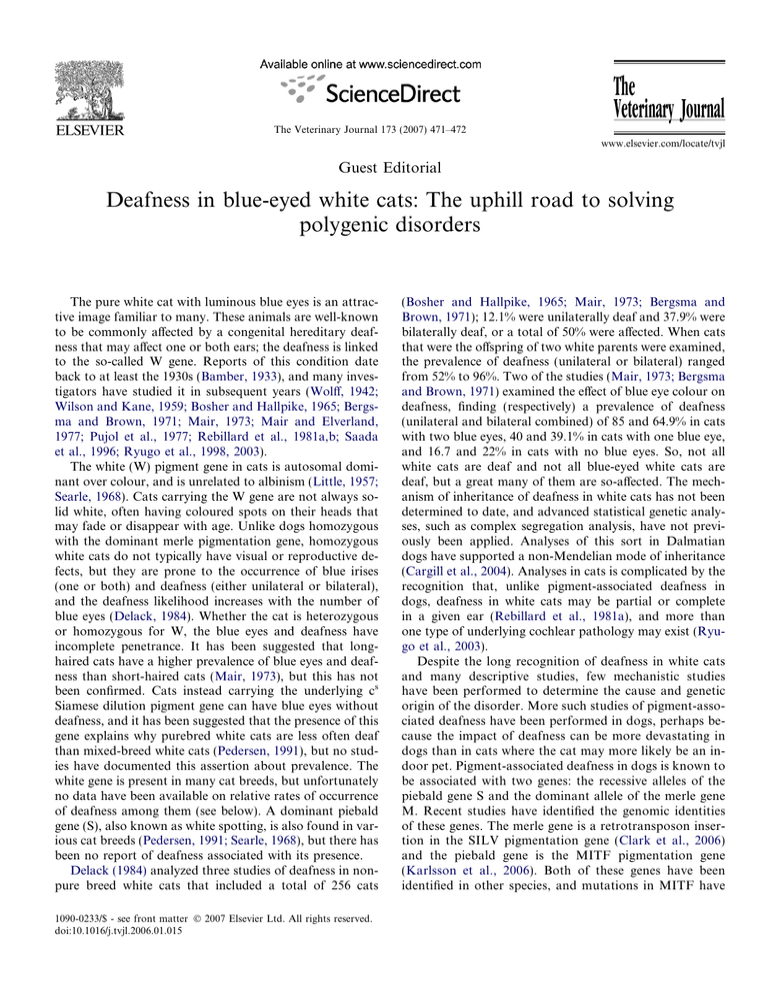
The
Veterinary Journal
The Veterinary Journal 173 (2007) 471–472
www.elsevier.com/locate/tvjl
Guest Editorial
Deafness in blue-eyed white cats: The uphill road to solving
polygenic disorders
The pure white cat with luminous blue eyes is an attractive image familiar to many. These animals are well-known
to be commonly affected by a congenital hereditary deafness that may affect one or both ears; the deafness is linked
to the so-called W gene. Reports of this condition date
back to at least the 1930s (Bamber, 1933), and many investigators have studied it in subsequent years (Wolff, 1942;
Wilson and Kane, 1959; Bosher and Hallpike, 1965; Bergsma and Brown, 1971; Mair, 1973; Mair and Elverland,
1977; Pujol et al., 1977; Rebillard et al., 1981a,b; Saada
et al., 1996; Ryugo et al., 1998, 2003).
The white (W) pigment gene in cats is autosomal dominant over colour, and is unrelated to albinism (Little, 1957;
Searle, 1968). Cats carrying the W gene are not always solid white, often having coloured spots on their heads that
may fade or disappear with age. Unlike dogs homozygous
with the dominant merle pigmentation gene, homozygous
white cats do not typically have visual or reproductive defects, but they are prone to the occurrence of blue irises
(one or both) and deafness (either unilateral or bilateral),
and the deafness likelihood increases with the number of
blue eyes (Delack, 1984). Whether the cat is heterozygous
or homozygous for W, the blue eyes and deafness have
incomplete penetrance. It has been suggested that longhaired cats have a higher prevalence of blue eyes and deafness than short-haired cats (Mair, 1973), but this has not
been confirmed. Cats instead carrying the underlying cs
Siamese dilution pigment gene can have blue eyes without
deafness, and it has been suggested that the presence of this
gene explains why purebred white cats are less often deaf
than mixed-breed white cats (Pedersen, 1991), but no studies have documented this assertion about prevalence. The
white gene is present in many cat breeds, but unfortunately
no data have been available on relative rates of occurrence
of deafness among them (see below). A dominant piebald
gene (S), also known as white spotting, is also found in various cat breeds (Pedersen, 1991; Searle, 1968), but there has
been no report of deafness associated with its presence.
Delack (1984) analyzed three studies of deafness in nonpure breed white cats that included a total of 256 cats
1090-0233/$ - see front matter Ó 2007 Elsevier Ltd. All rights reserved.
doi:10.1016/j.tvjl.2006.01.015
(Bosher and Hallpike, 1965; Mair, 1973; Bergsma and
Brown, 1971); 12.1% were unilaterally deaf and 37.9% were
bilaterally deaf, or a total of 50% were affected. When cats
that were the offspring of two white parents were examined,
the prevalence of deafness (unilateral or bilateral) ranged
from 52% to 96%. Two of the studies (Mair, 1973; Bergsma
and Brown, 1971) examined the effect of blue eye colour on
deafness, finding (respectively) a prevalence of deafness
(unilateral and bilateral combined) of 85 and 64.9% in cats
with two blue eyes, 40 and 39.1% in cats with one blue eye,
and 16.7 and 22% in cats with no blue eyes. So, not all
white cats are deaf and not all blue-eyed white cats are
deaf, but a great many of them are so-affected. The mechanism of inheritance of deafness in white cats has not been
determined to date, and advanced statistical genetic analyses, such as complex segregation analysis, have not previously been applied. Analyses of this sort in Dalmatian
dogs have supported a non-Mendelian mode of inheritance
(Cargill et al., 2004). Analyses in cats is complicated by the
recognition that, unlike pigment-associated deafness in
dogs, deafness in white cats may be partial or complete
in a given ear (Rebillard et al., 1981a), and more than
one type of underlying cochlear pathology may exist (Ryugo et al., 2003).
Despite the long recognition of deafness in white cats
and many descriptive studies, few mechanistic studies
have been performed to determine the cause and genetic
origin of the disorder. More such studies of pigment-associated deafness have been performed in dogs, perhaps because the impact of deafness can be more devastating in
dogs than in cats where the cat may more likely be an indoor pet. Pigment-associated deafness in dogs is known to
be associated with two genes: the recessive alleles of the
piebald gene S and the dominant allele of the merle gene
M. Recent studies have identified the genomic identities
of these genes. The merle gene is a retrotransposon insertion in the SILV pigmentation gene (Clark et al., 2006)
and the piebald gene is the MITF pigmentation gene
(Karlsson et al., 2006). Both of these genes have been
identified in other species, and mutations in MITF have
472
Guest Editorial / The Veterinary Journal 173 (2007) 471–472
been identified as causative for deafness in humans and
mice; MITF is one of the six genes identified to date as
being responsible for the four forms of Waardenburg syndrome (Van Camp and Smith, 2007). To date no mutation
in SILV or MITF has been identified as causative for canine deafness.
The study by Geigy et al. (2007) reported in this issue of
The Veterinary Journal examined deafness in a German
colony of cats, most of them white, finding deafness prevalence values consistent with earlier reports. Complex segregation analysis, using maximum likelihood procedures,
was performed to determine the most probable mode of
inheritance of deafness and blue eyes. Their results suggested the best model to be a pleiotropic gene segregating
for deafness and blue irises, with additional polygenic effects. This recognition that deafness in blue-eyed white cats
does not follow simple Mendelian genetics is not surprising, as a simpler mode of inheritance would probably have
been recognized long ago and used to reduce deafness prevalence. Progress in reducing deafness will most likely require identification of the genomic identity of W – like
the SILV or MITF genes in dogs – followed by identification of changes in that gene causative for deafness. Studies
to identify W are in progress, and may in fact be complete
by the time of this publication.
A bonus in the study by Geigy et al. (2007) was the report of hearing prevalence data for three specific cat
breeds: Norwegian Forest, Maine Coon, and Turkish Angora, with deafness prevalence rates of 18%, 17%, and
11%, respectively, based on 329, 134, and 474 subjects.
Analyses of iris and coat colour were not reported, but
the subjects included both white and pigmented variants,
so the deafness prevalence among the whites was likely similar to that reported for mixed-breed white cats, belying the
assertion that deafness prevalence rates are lower in pure
breed white cats (Pedersen, 1991). Although the data are
limited (underestimates) because some are based on behavioural assessments instead of the more reliable brainstem
auditory evoked response, they still represent the first published data on pure breed cats instead of the usually mixedbreed cats of the Geigy colony and earlier studies. More
data and studies along these lines would be welcome.
The great number of hereditary disorders in domestic
species is finally beginning to come under scrutiny with
the new availability of genome maps and a rapidly expanding collection of tools for molecular genetics – and a growing cadre of clinical scientists eager to tackle them. Since
the great majority of these disorders are polygenic or fail
to follow Mendelian genetics, the road to solving their
causes will not be easy or straightforward. Nevertheless,
the rewards are there and it is gratifying to see the progress
that is already being made.
George M. Strain
Louisiana State University,
Comparative Biomedical Sciences,
School of Veterinary Medicine,
Baton Rouge, LA 70803, USA.
E-mail address: strain@lsu.edu
References
Bamber, R.C., 1933. Correlation between white coat colour, blue eyes and
deafness in cats. Journal of Genetics 27, 407–413.
Bergsma, D.R., Brown, K.S., 1971. White fur, blue eyes, and deafness in
the domestic cat. Journal of Heredity 62, 171–185.
Bosher, S.K., Hallpike, C.S., 1965. Observations of the histological
features, development and pathogenesis of the inner ear degeneration
of the deaf white cat. Proceedings of the Royal Society of London B
162, 147–170.
Cargill, E.J., Famula, T.R., Strain, G.M., Murphy, K.E., 2004. Heritability and segregation analysis of deafness in U.S. Dalmatians.
Genetics 166, 1385–1393.
Clark, L.A., Wahl, J.M., Rees, C.A., Murphy, K.E., 2006. Retrotransposon insertion in SILV is responsible for merle patterning of the
domestic dog. Proceedings of the National Academy of Sciences 103,
1376–1381.
Delack, J.B., 1984. Hereditary deafness in the white cat. Compendium on
Continuing Education for the Practicing Veterinarian 6, 609–619.
Geigy, C.A., Heid, S., Steffen, F., Danielson, K., Jaggy, A., Gaillard, C.,
2007. Does a pleiotropic gene explain deafness and blue irises in white
cats? The Veterinary Journal 173, 548–553.
Karlsson, E.K., Hillbertz, N.S., Wade, C.M., Andersson, G., von Euler,
H., Hedhammar, Å., Zody, M.C., Biagi, T., Lai, J., Anderson, N., Liu,
G., Jones, K., Andersson, L., Lindblad-Toh, K., 2006. Two-stage
association mapping in dogs identifies coat color locus. In: Third
International Conference on Advances in Canine and Feline Genomics, Davis, CA, August 2006.
Little, C.C., 1957. The Inheritance of Coat Color in Dogs. Howell, New
York.
Mair, I.W.S., 1973. Hereditary deafness in the white cat. Acta Otolaryngologica (Suppl. 314), 1–48.
Mair, I.W., Elverland, H.H., 1977. Hereditary deafness in the cat. An
electron microscopic study of the stria vascularis and Reissner’s
membrane. Archives of Otorhinolaryngology 217, 199–217.
Pedersen, N.C., 1991. Feline Husbandry. American Veterinary Publications, Goleta, CA.
Pujol, R., Rebillard, M., Rebillard, G., 1977. Primary neural disorders in
the deaf white cat cochlea. Acta Otolaryngologica 83, 59–64.
Rebillard, M., Rebillard, G., Pujol, R., 1981a. Variability in the hereditary
deafness in the white cat. I. Physiology. Hearing Research 5, 179–187.
Rebillard, M., Pujol, R., Rebillard, G., 1981b. Variability in the hereditary
deafness in the white cat. II. Histology. Hearing Research 5, 189–200.
Ryugo, D.K., Rosenbaum, B.T., Kim, P.J., Niparko, J.K., Saada, A.A.,
1998. Single unit recordings in the auditory nerve of congenitally deaf
white cats: morphological correlates in the cochlea and cochlear
nucleus. Journal of Comparative Neurology 397, 532–548.
Ryugo, D.K., Cahill, H.B., Rose, L.S., Rosenbaum, B.T., Schroeder,
M.E., 2003. Separate forms of pathology in the cochlea of congenitally
deaf white cats. Hearing Research 181, 73–84.
Saada, A.A., Niparko, J.K., Ryugo, D.K., 1996. Morphological changes
in the cochlear nucleus of congenitally deaf white cats. Brain Research
736, 315–328.
Searle, A.G., 1968. Comparative Genetics of Coat Colour in Mammals.
Logos Press, London.
Van Camp, G., Smith, R.J.H. Hereditary Hearing Loss Homepage.
<http://webhost.ua.ac.be/hhh/> (accessed January, 2007).
Wilson, T.G., Kane, F., 1959. Congenital deafness in white cats. Acta
Otolaryngologica 50, 269–277.
Wolff, D., 1942. Three generations of deaf white cats. Journal of Heredity
33, 39–43.



